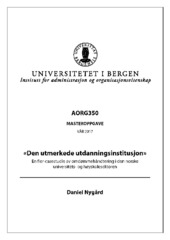| dc.contributor.author | Nygård, Daniel | |
| dc.date.accessioned | 2017-06-23T09:17:58Z | |
| dc.date.available | 2017-06-23T09:17:58Z | |
| dc.date.issued | 2017-06-22 | |
| dc.date.submitted | 2017-06-21T22:00:04Z | |
| dc.identifier.uri | https://hdl.handle.net/1956/16086 | |
| dc.description.abstract | Oppgaven ser på noen viktige aspekter ved omdømmehåndtering i UH-sektoren. Tre undersøkelser er utført, som kartlegger 1) omdømmetiltak, 2) markedskommunikasjon og 3) rektors rolle. Et hovedfunn er at utdanningsinstitusjonene er opptatt av sitt omdømme, og kjennetegnet av høy utadvendthet og store, sentralt plasserte kommunikasjonsavdelinger. Rektor ser ut til å ha en viktig rolle, og er helt sentral både i arbeidet med å promotere og forsvare institusjonen. Til en viss grad kan man se tendenser til merkevarebygging, men det er utfordringer med å skape en enhetlig profil som har en distingverende effekt. Fremstillingen av egen fortreffelighet er forholdsvis moderat, også på de mest prestisjefylte institusjonene. Anbefalingene i den praktiske omdømmelitteraturen ser ut til å ha blitt tilpasset, og det kan sees spor av en oversatt omdømmeoppskrift for akademia. Tilpassingene kan sees som nødvendige ut i fra lokale, nasjonale og sektorielle forhold, og kan tenkes å være positive for lærestedenes omdømme. Det er foreslått å forstå akademiske institusjoners omdømme langs to grunnleggende dimensjoner; sosial ansvarlighet og akademisk kvalitet. Idealtypen den utmerkede utdanningsinstitusjon kombinerer høye verdier på de to dimensjonene, men illustrerer også de mange ulike og potensielt motstridende forventningene til norske læresteder som de i større eller mindre grad kan innfri. | en_US |
| dc.description.abstract | Branding and strategic communication are important practices for contemporary organizations, in the private as well as the public sector. Implementation of new organizational practices, artefacts and structural components, and revision or reinforcement of existing organizational features, can be linked to a concern for the organizations overall reputation. Parts of the reputation management literature is found to be grounded in a particular perspective on organizations, and to recommend similar methods for how an organization can attain the ultimate goal: to stand out and achieve a "winning" reputation. In this thesis, higher education institutions in Norway are examined. Findings indicate that the approach to manage and handle reputation-related issues varies in some aspects from the recommendations found in the reputation management literature. These institutions have features resembling the "ideal" of the reputation literature: a high degree of visibility, an active approach towards different stakeholders and society, and the presence of relatively comprehensive communication departments. However, the communication departments are found to assume a more restrained position and leave the center stage to the academics, students and to the university's president, the latter found to be a central and highly visible spokesperson for the institution. The HEIs also have considerable problems with promoting a unique and consistent institutional profile. The prominent role of the university president and the less distinct, more complex and sometimes inconsistent self-presentation of these institutions, as suggested by findings, can be seen as the result of a translation process where the HEIs local orders and historically inherited traits meet with both branding and strategic communication pressures and isomorphic pressure from the environment. It is argued that the approach to reputation found at the HEIs can be a more suitable solution to deal with the diverse and partly conflicting expectations from internal and external stakeholders than the approach suggested in the reputation management literature. The thesis further suggest that the Norwegian HEIs reputation can be conceptualized along two essential dimensions: academic quality and social responsibility. Some might enjoy the public perception of having a high standard on both dimensions, a phenomenon dubbed the “outstanding institution”. More commonly, an institution can be associated with the concept of an “ambitious institution” or a “socially responsible institution”, facing challenges in search of a status as outstanding with a "winning" reputation. | en_US |
| dc.language.iso | nob | eng |
| dc.publisher | The University of Bergen | eng |
| dc.subject | omdømme | eng |
| dc.subject | høyere utdanning | eng |
| dc.subject | university college | eng |
| dc.subject | branding corporate communication | eng |
| dc.subject | omdømmebygging | eng |
| dc.subject | university | eng |
| dc.subject | omdømmehåndtering | eng |
| dc.subject | merkevarebygging | eng |
| dc.subject | higher education | eng |
| dc.subject | strategisk kommunikasjon | eng |
| dc.subject | høyskole reputation management | eng |
| dc.subject | universitet | eng |
| dc.title | "Den utmerkede utdanningsinstitusjon" - En fler-casestudie av omdømmehåndtering i den norske universitets- og høyskolesektoren. | eng |
| dc.title.alternative | The outstanding institution - Reputation management in Norwegian higher education institutions. | eng |
| dc.type | Master thesis | en_US |
| dc.date.updated | 2017-06-21T22:00:03Z | |
| dc.rights.holder | Copyright the author. All rights reserved. | en_US |
| dc.description.degree | Masteroppgave i administrasjon og organisasjonsvitenskap | |
| dc.description.localcode | AORG350 | |
| dc.description.localcode | MASV-AORG | |
| dc.subject.nus | 731111 | eng |
| fs.subjectcode | AORG350 | |
| fs.unitcode | 15-12-00 | |
